Common Treatments
Crowding of the teeth
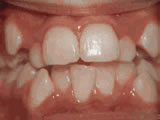 Before
Before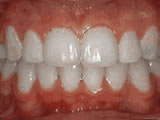 After
AfterPatient started treatment at age 11 and wore braces for 26 months. He loves his new smile.
Open bite - Front teeth don't touch
 Before
Before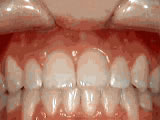 After
AfterPatient sucked her thumb as a young child. She started treatment at age 13. She had braces and a special appliance — called a crib — to retrain the tongue, for 28 months. Now she can bite the lettuce out of a sandwich.
Deep overbite - Lower front teeth bite into palate
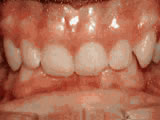 Before
Before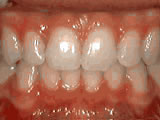 After
AfterThis adult patient, age 25, required braces and jaw surgery to correct his severe overbite, with treatment taking two years. His problem could have been corrected without surgery if he had been treated before he was a teenager.
Missing lateral incisors
 Before
Before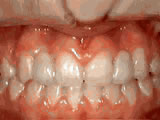 After
AfterThis patient's lateral incisors were congenitally missing. She had braces for 20 months to move the teeth into their correct positions, then the missing teeth were replaced with bonded "Maryland" bridges.
Underbite - Lower front teeth in front of upper teeth
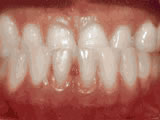 Before
Before After
AfterPatient's underbite was causing her jaw joint discomfort and excessive wear patterns on her teeth. After about 30 months of treatment starting at age 32, she now finds smiling and chewing much easier.
Spacing of teeth
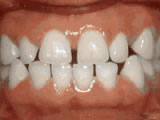 Before
Before After
AfterPatient was bothered by the spaces between his teeth. Braces closed the spaces and gave him an ideal bite in 24 months. Special glued-in retainers help keep the spaces closed.
Overjet - Protruding front teeth
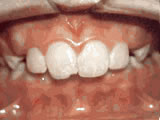 Before
Before After
AfterAt age ten, patient had a big overjet with the top teeth protruding beyond the bottom. She had two phases of treatment. The first helped her jaws to grow more harmoniously and the second aligned her teeth and bite. At age 13, she was proudly displaying her new smile.
Phase-One
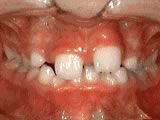 Before
Before After
AfterPatient's parents were concerned about both aesthetics and the health of the erupting permanent teeth when they brought him to the orthodontist at age eight. The lower front teeth were crowded and touching the palate, and the upper front teeth were extremely displaced from their normal positions. After 12 months of Phase-One treatment with an expander and partial braces, patient's appearance and dental function were vastly improved.
TMJ-TMD

Temporomandibular Disorder
Millions of Americans suffer from chronic facial and neck pain as well as severe, recurring headaches. In some cases, this pain is due to Temporomandibular Disorder, also known as TMD.
Your temporomandibular joints, or TMJs, connect your lower jawbone to your skull. These joints get a lot of use throughout the day as you speak, chew, swallow, and yawn. Pain in and around these joints can be unpleasant and may even restrict movement.
Symptoms of TMD include:
- Pain in the jaw area
- Pain, ringing, or stuffiness in the ears
- Frequent headaches or neck aches
- Clicking or popping sound when the jaw moves
- Muscle spasms in the jaw area
- A change in the alignment of top and bottom teeth
- Locked jaw or limited opening of the mouth
If you notice that you are experiencing any of these symptoms, let your doctor know at your next appointment. Your doctor can help determine if you have TMD and create a customized treatment plan to help relieve your symptoms.
Not all jaw pain is associated with TMD.
If you feel that you might have TMD, it is always important to see your dentist and receive an exam. However, not all jaw pain is associated with TMD, and if you do not have TMD there are many different preventive steps you can take to maintain a healthy, strong smile.
- Relax your face — "Lips together, teeth apart"
- Avoid grinding your teeth
- Avoid all gum chewing
- Don't cradle the phone receiver between your head and shoulder — either use a headset or hold the receiver to your ear
- Chew food evenly on both sides of your mouth
- Do not sit with your chin rested on your hand
- Practice good posture — keep your head up, back straight, and shoulders squared
Many people get TMD without ever having braces. Symptoms usually come and go regardless of whether braces are worn. If you are experiencing any of the symptoms listed above and are concerned that you're a candidate for TMD treatment, please contact our office for a consultation.
